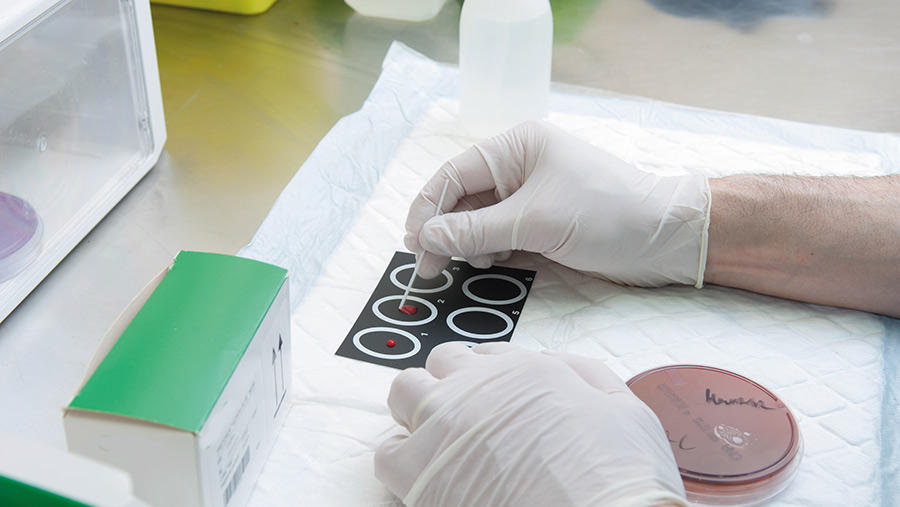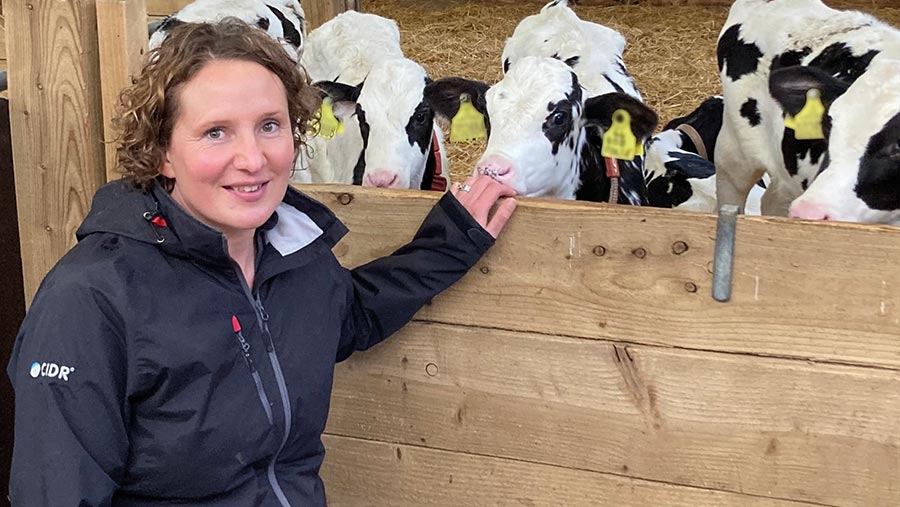A guide to mastitis treatment options and efficacy for dairy cows
 Analysing bacteria © Antoine Photographe/Adobe Stock
Analysing bacteria © Antoine Photographe/Adobe Stock Mastitis is a major challenge for dairy farmers, from both cow health and economic perspectives, with recent figures from Kingshay estimating a cost/case of £386 – based on a milk price of 50p/litre.
Though advances have been made in the management of udder health – and therefore the onset of mastitis – in recent years, there is still a need for treatment of clinical mastitis cases.
Jude Roberts, Map of Ag, authored a recent paper looking at the options and efficacy of different mastitis treatments.
See also: 6 ways to reduce the risk of high bactoscan in bulk milk

Jude Roberts © Jude Roberts
Current outlook
The main option for treating mastitis is with intramammary antibiotics.
Three category D and four category C antibiotics are currently available, each with differing tubing intervals and treatment durations. This may affect choice of product, says Mrs Roberts.
Good practice dictates using antibiotic treatments alongside non-steroidal anti-inflammatory drugs (NSAIDs), of which there are four active ingredients licensed for use in the UK: carprofen, flunixin, ketoprofen and meloxican.
The actions from these are anti-inflammatory, anti-pyretic (reducing fever), anti-endotoxic (fighting bacterial toxins) and analgesic (pain-relieving).
“We’re using them [NSAIDs] a lot more than we were. Because bacteria cause the release of pro-inflammatory mediators, which cause multiple effects, we’re really reliant on the use of non-steroidals to minimise these effects.”
There are positives and negatives to their usage, but the literature weighs in favour of the benefits, she adds. “There is evidence that NSAIDs are beneficial in all cases of clinical mastitis – mild, moderate and severe.”
Corticosteroids are another option. Three of the current intramammary preparations contain corticosteroids and there are injectable options, too.
However, due to the implications for the wider immune system and the non-specific nature of these treatments on reducing inflammation, there should be a move away from using these injectable products in treatment protocols, she says.
Intramammary preparations, particularly where treatment is localised, can still be useful.
Alternative therapies
Alternative therapy options include three products licensed for extended therapy.
For Staphylococcus aureus, these are Synulox LC and Combiclav, which have no maximum treatment durations. For streptococci – or staphylococci during lactation – Ubropen can be used.
Looking at the evidence behind these treatments, Mrs Roberts says there are no benefits to using extended therapy over conventional therapy.
Therefore, where the pathogen is unknown, normal treatment periods are more than sufficient.
The exception is in cases of Streptococcus uberis, where research has shown increased bacteriological cure was demonstrated with extended therapy, she explains.
This has also been shown in cows with persistently high cell counts when treating subclinical mastitis caused by Strep. uberis.
The use of boluses is also gathering more traction as an alternative therapy, including one which uses the “active” ingredient in garlic, called allicin.
This has been proven to have anti-inflammatory and antioxidant benefits, says Mrs Roberts.
Usage is only advised in cases of high somatic cell counts (over 500,000 cells/ml), but one of the big benefits is that there is no milk withdrawal period.
The downside of allicin is that it has a chemical half life of just three hours. Mrs Roberts adds that great care should be taken if using an alternative therapy such as a bolus instead of a proven, licensed option.
Future therapies
Innovation in mastitis treatment is developing. Potential new treatments include immunomodulators, which are designed to enhance the immune system and are therefore targeted at preventing mastitis.
Such products are already licensed for cats and dogs.
Bacteriophages may also be used for future treatment. These are viruses that target specific bacteria.
“They sound extremely promising, in terms of what they might do, but the negative with them is that you can still get resistance and evolution of the virus, so in time they might lose their integrity,” warns Mrs Roberts.
Antimicrobial peptides are a further possible future therapy, which are described as “new-generation antibiotics”.
While these are unlikely be on the market any time soon, they are the focus of intense research at present.
Lactic acid bacteria treatment is being trialled by several farmers who are using it as a probiotic – either as a teat dip or spray post-milking – to reduce colonisation.
“There is a little bit of literature around this, but really not good comparative studies in terms of what it’s doing and if it’s showing a reduction in mastitis.”
Treatment advice
Mrs Roberts recommends using intramammary options to treat new cases promptly, as well as the use of NSAIDs in all cases.
“Don’t rush for injectable antibiotics – use them in severe cases. Do look out for new technology, particularly bacteriophages and antibody therapy.
“Whenever you are changing treatment, monitor your own cure rates and response to therapies and changes you make.
“The most straightforward way of doing that would be looking at the proportion of cows that are only infected once, or the proportion of cows that have no further clinical signs and remain at a low cell count.”
Bolus benefits for Devon dairy
Sam Wakeham manages a 600-cow dairy farm near Barnstaple in Devon. He has been trialling the use of garlic boluses to manage mastitis, and so far, has seen good results.
After facing challenges with cows calving in with high cell counts, Mr Wakeham was approached by a company that was marketing the boluses and set about testing the treatment on his farm.
“I did my own trials on 12 cows because I was very sceptical about how it would work. After the first milk recording, we looked at the data and it proved it had worked.”
Since the initial trial, Mr Wakeham has continued to use the boluses and says they have continued to bring improvements to cell counts – more so than the use of antibiotics.
This is part of a wider move away from the use of antibiotics for mastitis treatment, where possible, he adds.
“We now use non-antibiotic treatments and boluses to treat mastitis unless it’s a chronic cow, and then we’ll use antibiotics. We’re also trying to cull hard.”
With inflated milk prices at present, being able to incorporate therapies like the boluses are providing a big cost-saving benefit too, adds Mr Wakeham.
“Our mastitis has never been a major problem, but like every dairy farm, it is a problem, so we’re just trying to use as few antibiotics as possible – especially when milk is nearly 50p/litre.”
Jude Roberts was speaking at the British Mastitis Conference, held at Sixways Stadium, Worcester on 9 November 2022
